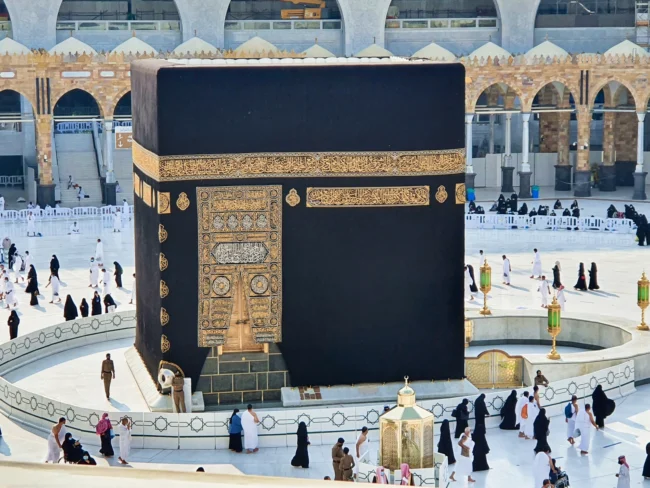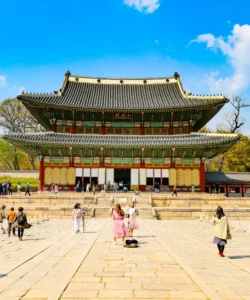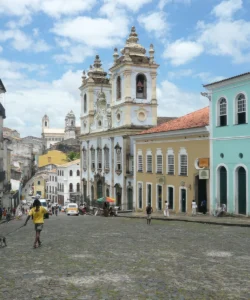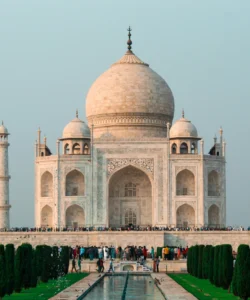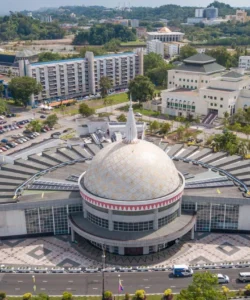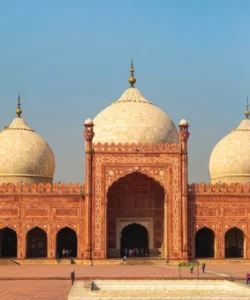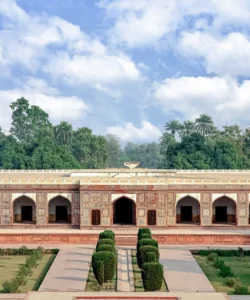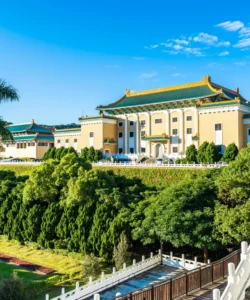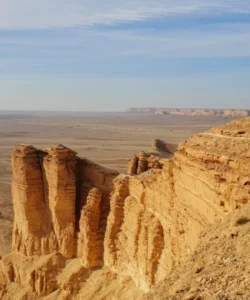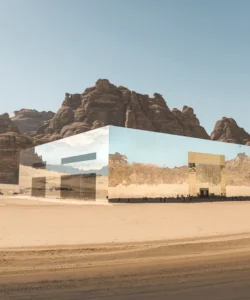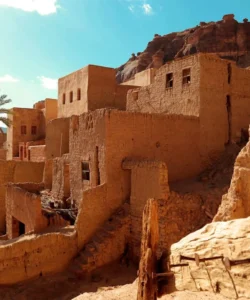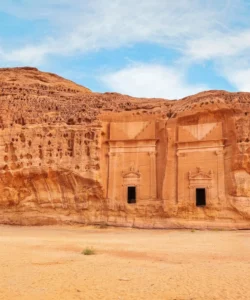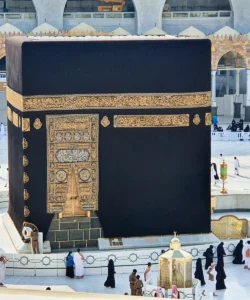The Kaaba (Arabic: ٱلْكَعْبَة, romanized: al-Kaʿbah, lit. ‘The Cube’) is the most sacred site in Islam and is located within Al-Masjid Al-Haram (The Sacred Mosque) in the city of Mecca, Saudi Arabia. It is not worshipped by Muslims but serves as the Qiblah, the direction towards which Muslims worldwide turn in prayer five times a day. It is the central focal point of the Hajj and Umrah pilgrimages.
Name: Kaaba (often transliterated as Ka’bah, Kabah, Cube, House of God; also known as Bayt Allah, The Sacred House)
Address: At the very center of the courtyard (Mataf) of Al-Masjid Al-Haram, Mecca City, Mecca Province, Saudi Arabia.
How to Get There:
Access to the Kaaba and the city of Mecca is strictly restricted to Muslims only. Non-Muslims are prohibited from entering the holy city.
- By Air: The closest international airport for pilgrims is King Abdulaziz International Airport (JED) in Jeddah. From Jeddah, there are well-established transportation networks (buses, taxis, private cars) or the high-speed Haramain Railway connecting to Mecca (approx. 1-1.5 hours drive/ride).
- By Road: Mecca is well-connected by modern highways from all parts of Saudi Arabia.
- Pilgrimage Regulations: During Hajj and Umrah seasons, millions of pilgrims arrive. Special visas (Hajj or Umrah visas) are required and issued according to the Islamic lunar calendar.
- Within Al-Masjid Al-Haram: The Kaaba is in the open courtyard of the mosque. Pilgrims perform rituals like Tawaf (circumambulation) around it. The vast mosque complex is designed for massive pedestrian flow, with numerous gates, escalators, and lifts.
- Best Time to Visit: The Kaaba is a constant center of activity, 24 hours a day, 7 days a week. The peak times are during the annual Hajj pilgrimage (month of Dhu al-Hijja) and the Umrah pilgrimage (can be performed anytime). These periods see the largest gatherings, with millions of people.
Landscape and Architecture:
The Kaaba’s “architecture” is a symbol of elegant simplicity, spiritual profundity, and ancient origins, deeply embedded in Islamic tradition.
- Cubic Shape: The Kaaba is a roughly cubic stone structure, approximately 12 meters (39 feet) long, 10 meters (33 feet) wide, and 15 meters (49 feet) high. Its name “Kaaba” itself means “cube” or “quadrangular shape” in Arabic. It’s built from grey granite.
- The Kiswa: The exterior of the Kaaba is famously covered with the Kiswa, a magnificent black silk cloth that is intricately embroidered with Quranic verses in gold and silver thread. A new Kiswa is traditionally produced and draped annually, typically before the Hajj pilgrimage. The black color tradition dates back to the Abbasid dynasty.
- The Black Stone (Al-Hajar al-Aswad): Embedded in the eastern corner of the Kaaba, about 1.5 meters (5 feet) up from the ground, is the revered Black Stone. It is believed to have descended from heaven. Pilgrims traditionally attempt to kiss or touch it as they begin and end each circuit of the Tawaf.
- The Door of the Kaaba (Bab al-Tawbah): A golden door, positioned on the northeast side, is raised about 2.3 meters (7.5 feet) above the ground. This door is rarely opened to the public, typically only for cleaning ceremonies.
- The Gutter (Mizab al-Rahmah): A golden gutter (or water spout) is located on the roof of the Kaaba, designed to drain rainwater from the roof.
- Maqam Ibrahim (Station of Abraham): A golden cage-like structure near the Kaaba, housing a stone believed to bear the footprint of Prophet Abraham, who stood on it while building the upper parts of the Kaaba.
- Hateem (Hijr Ismail): A low, semi-circular wall made of white marble, located adjacent to the northwestern wall of the Kaaba. It is considered part of the Kaaba itself, and circumambulation (Tawaf) must include this area.
- Interior (Rarely Seen): The interior of the Kaaba is a relatively simple, open space. It features white marble floors, rose-colored marble walls (up to 4 meters high), and three wooden pillars (made of sandalwood) that support the roof. Lanterns and incense burners hang from the ceiling. It contains markers for the Prophet Muhammad’s prayer spot.
- No Windows: The Kaaba has no windows, only the single golden door.
- Open Courtyard (Mataf): The Kaaba stands at the very center of the vast, open-air Mataf, a circular space paved with white stone, designed for millions of pilgrims to circumambulate (Tawaf) simultaneously.
What Makes It Famous:
- Holist Site in Islam: The Kaaba is the most sacred and revered site in all of Islam. It is the Qiblah (direction of prayer) for over two billion Muslims worldwide, making it the spiritual center of the entire Islamic faith.
- Built by Prophets Ibrahim and Ismail: Muslims believe the Kaaba was originally constructed by Prophet Abraham (Ibrahim) and his son Prophet Ishmael (Ismail) as the first House of Worship dedicated to the One God (Allah), giving it immense historical and prophetic significance.
- Central to Hajj and Umrah Pilgrimages: It is the absolute core of the mandatory Hajj pilgrimage (one of the Five Pillars of Islam) and the voluntary Umrah pilgrimage. Millions of Muslims annually converge here to perform the ritual circumambulation (Tawaf) around the Kaaba.
- Symbol of Monotheism and Unity: The Kaaba symbolizes the oneness of God (Allah) and serves as a powerful unifying symbol for Muslims globally, emphasizing equality and humility as pilgrims gather regardless of status or nationality.
- The Black Stone: The revered Black Stone embedded in its corner is a significant relic, touched and kissed by pilgrims in emulation of Prophet Muhammad.
- The Kiswa: The annual draping of the Kaaba with the magnificent black and gold Kiswa is a globally recognized tradition and a symbol of devotion.
- Historical and Prophetic Role: It has been a site of worship since ancient times, purified by Prophet Muhammad from idol worship, and its history is deeply intertwined with the origins and development of Islam.
Differences from Some Other Wonders:
- Ultimate Religious Centrality: While other sites are sacred within specific faiths (e.g., Vatican City for Catholicism, Pashupatinath Temple for Hinduism, Lumbini for Buddhism), the Kaaba holds a unique and universal centrality for the entire global Muslim community as the single direction of prayer for billions and the epicenter of their most important pilgrimage.
- Focus on Ritual Performance and Symbolic Core: Unlike architectural wonders that might be grand buildings for general public access (e.g., Taj Mahal, Red Fort, Lahore Fort) or even vast temple complexes with numerous structures (e.g., Angkor Wat, Borobudur), the Kaaba’s design is minimalist and singularly focused on facilitating the ritual circumambulation (Tawaf) around its cubic form. Its “architecture” serves a specific ritualistic function.
- Dome-less Structure: In stark contrast to most grand mosques and mausoleums worldwide, which are often crowned by magnificent domes (e.g., Badshahi Mosque, Sultan Omar Ali Saifuddien Mosque, Taj Mahal), the Kaaba famously lacks a dome. Its simple cubic shape is its defining architectural characteristic.
- Exclusive Access (Muslims Only): The strict prohibition of non-Muslims from entering Mecca and specifically the Kaaba area makes it a highly exclusive and sacred destination, distinguishing it from most other global wonders that are open to all visitors.
- Not a “Building” in a Conventional Sense (for worship): While it’s a structure, it’s not a mosque in the traditional sense with interior prayer halls for congregational prayers (though prayers are performed around it). Its spiritual function is primarily as a central point of orientation and circumambulation.
- Constantly Active and Dynamic: Unlike historical sites or ruins, the Kaaba is a living, vibrant, and constantly active center of worship and pilgrimage, with millions of people performing rituals around it at all hours of the day, year-round. This continuous human activity and spiritual energy are a unique aspect.
- Simplicity Amidst Grandeur: Despite being at the heart of the world’s largest mosque, the Kaaba itself remains a simple, unadorned (except for the Kiswa) cubic stone structure, allowing its profound spiritual meaning to stand unhindered by excessive ornamentation.
Kaaba Photos:
[envira-gallery id=”17362″]
